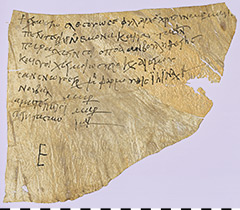P. 8977 (SPP III2.2 129)
The exhibit gives an example, how surviving textual witnesses refer to daily and common procedures and nonetheless include peculiarities which bring up questions unsolved. Its provenance, the Nubian Gebelên, was guaranteed by the notation of a trustworthy merchant. Moreover, it is part of a larger group of texts, connected by topic and external characteristics. Nine lines have been written in Greek on the pelt side of a piece of leather. This writing material is of great rarity. Its frequency compared to other materials is, if at all, in the lower per thousand range. The skin didn’t undergo any specific procedures of preparing parchment. The leather materials of the group show small holes at regular intervals for needle and thread. It might be assumed, that they had been in daily use as pieces of cloth before. Writing on the pelt side is by far better preserved than on the meat side due to the lower fat rate. The dating around the 6th century A.D. can only be done the paleographic way. The text itself contains the day but not the year of the mentioned event. A dating to the last quarter of the 6th century has been proposed on the base of the development of the letters.
The document shows very well that people of such times were not so different from us. By this rag Sle confirms to have borrowed five golden Solidi from the phyle chief Ose and to give them back at any time according to his will. The scribe Sansnos indicates he has written the text on Pharmouti 18, (April 13) of the fifth indiction. Three persons are given as witnesses. After mentioning the sum in words and the numeral Epsilon, the numeral version is repeated well-sized at the end. Like other testimonies which worked as bills, checks and receipts this document from Gebelên brings us closer to the daily life of those ancient times. In this case we have a note of debt, similar to European financial practice. Especially in private negotiations this kind of document is still common. In modern banking the equivalent would be a credit agreement.
Now for the uncertainties: A Phyle is generally speaking a staff unit. The tracks of this kind of organization unit lead actually back to the Old Kingdom. The Greeks called an administration unit Phyle, which might have included kin relations. What is meant in this specific case has to remain undecided. The Solidus (nómisma) has been a common coin since Diocletian ended the special arrangements for currency in Egypt in 296 A.D. Its value at these times is uncertain due to the high rate of inflation. Dating by cycle of indiction is the typical form of dating in late antiquity. Without knowing the certain cycle of indiction, like in this case, the year remains unclear. Ose appears in other documents as creditor. Probably he had sufficient funds and was more or less used to financial practice. The scribe Sansnos on the other hand shows, especially in other documents, rather insufficient knowledge in Greek. It is presumed, that Greek wasn’t his mother tongue and he maybe just imitated the form. The naming of witnesses probably is to be understood as a connection of the documentary and the real world, which aims at supporting the liability of the note. The names refer to the Blemmyians, a people, who can be tracked in Greek sources back to the third century B.C. The Roman emperors had to deal with their attacks often in the south of the province. In the fifth century they were involved in the temporary establishment of the only pagan temple, the sanctuary of Isis, in the Christian Byzantine Empire which later was closed again by Justinian I. The exhibit shows that our daily negotiations are not so different from those of that rarely testified people.



